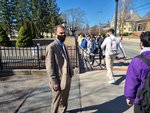


PAWTUCKET — Several dozen teenagers, all of them wearing masks, walked along Walcott Street on a recent mild Friday afternoon in Pawtucket’s Quality Hill District.
Daniel Richard, the principal of St. Raphael Academy, stood on the sidewalk, saying hello and greeting a few of the students by name as they walked to their classes across St. Ray’s urban campus.
“The kids have been very faithful about wearing their masks, and not complaining about it, which is refreshing to see,” Richard said as he later escorted a visitor inside one of St. Ray’s academic buildings, where signs with arrows directed foot traffic one way down the hallways.
Every classroom had brand-new air purifiers the size of boomboxes humming in the background while students, all of them masked, sat in desks positioned next to pieces of blue tape on the floor that ensured they kept more than six feet apart from one another.
“The spread of the virus dictates the steps that we take,” Richard said of the novel coronavirus, which has presented a host of challenges for school administrators to keep students and teachers safe until the new COVID-19 vaccines bring the country closer to herd immunity.
But the inconveniences and obstacles presented by the pandemic, which at times have been moving targets because of the evolving scientific data, have thus far not prevented Catholic schools in Rhode Island and elsewhere from safely educating students in the classroom since in-person instruction resumed last fall. “We don’t know of any cases where kids have infected other kids in our schools,” said Daniel J. Ferris, the superintendent of Catholic schools for the Diocese of Providence.
Ferris said that there have been confirmed cases this year of students contracting the novel coronavirus from extracurricular activities outside of school, such as sports. But as of mid-March, officials said there had not been any reported instances of community spread inside Catholic schools.
“Our schools have probably been the healthiest that they’ve ever been,” Ferris said. “We made the decision last April that in-person education was the right kind of Catholic education and we followed through with it. We’ve made it work.”
The success of Catholic schools safely reopening amid the pandemic stands somewhat in contrast to the struggles that larger public school systems across the country generally have had in bringing back in-person learning since COVID-19 swept through the nation last March and shut down entire sectors of society. Last spring, most Catholic schools were able to quickly transition to online learning, sometimes within the span of a single weekend.
“The day we closed the school, the next day the teachers and the students were all online,” said Richard, who noted that St. Ray’s has had the capability for virtual instruction since 2016. The school opened up last fall with a “hybrid” system where families had the option to send their children fully in-person, completely virtual, or a combination of both.
Richard estimated that 60 to 70 percent of St. Ray’s students attend in-person classes every day, and he hopes to increase that percentage more by next month. By the fall, he expects anywhere from two to five percent of students may still be attending classes online.
“It won’t be a large chunk of the student body like it is now,” Richard said. “But I don’t know if (virtual learning) is ever going to stop completely, now that all the schools are doing it now.”
For Richard and the St. Ray’s community, the pandemic hit close to home a year ago, when Vice Principal of Student Life Marc Thibault became the first confirmed patient in Rhode Island to be hospitalized with COVID-19.
“I was out of commission for three weeks. I had it really bad. I was ready to die,” said Thibault, who is believed to have contracted the virus while leading a class field trip to Europe last February. Thibault said he struggled for a while with low blood oxygen levels, but added that today he feels “fantastic,” and that his lungs and heart are healthy.
“I think God granted me another day to live because I have more to do. I feel lucky and I feel blessed to be here,” said Thibault, who monitors students’ compliance with the school’s various COVID-19 safety protocols, such as masking, social-distancing and answering a daily screening for coronavirus symptoms.
“Our students have been fantastic with following the procedures,” Thibault said.
Those protocols were created during weeks of planning meetings last spring and summer, when Catholic school officials consulted guidance from federal and state government agencies and medical organizations such as the American Academy of Pediatrics.
“What emerged was a picture of mitigation strategies: washing hands, social distancing, symptom checks, masks, having physical barriers like Plexiglas barriers on desks, pods or small groupings of students,” Ferris said. “Also contact tracing, making sure you had the same seating charts for every class so you knew exactly where kids were so if there was one kid in the corner of the classroom who happened to test positive or was a probable case, then you could draw a 10-foot circle around that student and see how many other students were within distance of that student.”
Said Ferris, “It seems kind of silly, but our principals walked around with tape measures so they could later figure out which students [were exposed to coronavirus], and which students were potentially close contacts.”
The Catholic schools in Rhode Island also hired custodians to regularly clean and sanitize restrooms. They also bought electrostatic sprayers to sanitize large surfaces, purchased air purifiers and medical-grade filters for HVAC systems, brought on additional full-time nurses and created temporary isolation rooms for students suspected of showing symptoms or having been exposed to the coronavirus. Federal coronavirus relief funding helped the schools afford some of those extra expenses.
“We’ve been focused this year on being mobile and being able to pivot quickly, and I think that’s one thing that Catholic schools have done a really good job on,” said Principal Richard, who noted that St. Ray’s spacious gymnasium has been used this year as the school cafeteria. The athletic teams take turns during the week setting up and breaking down the lunch tables and chairs.
As the academic year enters its final quarter, Ferris said the last six months have been difficult and exhausting at times, but that it’s also been “a very good year for kids in Catholic schools.”
“They’ve continued to receive the faith,” Ferris said. “Maybe not with the same texture or the same feel, but it’s all been there. It’s the same truth, the same conviction, the same strength of mission.”